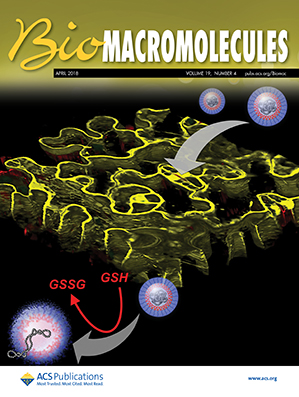Strategic Design of Biocompatible, Glistening-Free, and Foldable Artificial Intraocular Lenses Based on Hydro-Amphiphilic Ternary Copolymers
IF 5.4
2区 化学
Q1 BIOCHEMISTRY & MOLECULAR BIOLOGY
引用次数: 0
Abstract
The increasing prevalence of cataracts underscores the urgent need for intraocular lens (IOL) materials that provide optical clarity, foldability, glistening resistance, and long-term biocompatibility. In this study, we developed hydro-amphiphilic ternary copolymers composed of styrene, hydroxyethyl methacrylate (HEMA), and poly(ethylene glycol) phenyl ether acrylate (PEGPEA) to address these requirements. This rational design integrates the strength and refractive index of hydrophobic styrene with the flexibility and hydrophilicity of HEMA and PEGPEA. The optimized formulation (H3), comprising 50 wt % HEMA, 30 wt % PEGPEA, and 20 wt % styrene, showed excellent transparency after accelerated aging, sufficient modulus and elongation for safe surgical handling, and low cytotoxicity in CCK-8 assays. Cytokine analyses revealed no significant inflammatory response compared to a commercial hydrophobic acrylic IOL. These findings highlight hydro-amphiphilic copolymers as a promising next-generation material platform for IOLs, offering a biocompatible, glistening-free, and foldable solution for enhanced surgical outcomes and long-term patient satisfaction.
- Download: Download high-res image (164KB)
- Download: Download full-size image
基于水两亲性三元共聚物的生物相容性、无闪烁性和可折叠人工晶状体的策略设计。
白内障的日益流行强调了对具有光学清晰度、可折叠性、抗闪性和长期生物相容性的人工晶体(IOL)材料的迫切需求。在这项研究中,我们开发了由苯乙烯、甲基丙烯酸羟乙酯(HEMA)和聚乙二醇苯基醚丙烯酸酯(PEGPEA)组成的水两亲性三元共聚物来满足这些要求。这种合理的设计将疏水苯乙烯的强度和折射率与HEMA和PEGPEA的柔韧性和亲水性相结合。优化后的配方(H3),包括50 wt % HEMA, 30 wt % PEGPEA和20 wt %苯乙烯,在加速老化后显示出优异的透明度,具有足够的模量和伸长率,可以安全手术处理,并且在CCK-8试验中具有低细胞毒性。细胞因子分析显示,与商业疏水性丙烯酸人工晶体相比,没有明显的炎症反应。这些发现强调了水两亲共聚物作为下一代人工晶体材料平台的前景,它提供了一种生物相容性、无闪光、可折叠的解决方案,可提高手术效果和长期患者满意度。
本文章由计算机程序翻译,如有差异,请以英文原文为准。
求助全文
约1分钟内获得全文
求助全文
来源期刊

Biomacromolecules
化学-高分子科学
CiteScore
10.60
自引率
4.80%
发文量
417
审稿时长
1.6 months
期刊介绍:
Biomacromolecules is a leading forum for the dissemination of cutting-edge research at the interface of polymer science and biology. Submissions to Biomacromolecules should contain strong elements of innovation in terms of macromolecular design, synthesis and characterization, or in the application of polymer materials to biology and medicine.
Topics covered by Biomacromolecules include, but are not exclusively limited to: sustainable polymers, polymers based on natural and renewable resources, degradable polymers, polymer conjugates, polymeric drugs, polymers in biocatalysis, biomacromolecular assembly, biomimetic polymers, polymer-biomineral hybrids, biomimetic-polymer processing, polymer recycling, bioactive polymer surfaces, original polymer design for biomedical applications such as immunotherapy, drug delivery, gene delivery, antimicrobial applications, diagnostic imaging and biosensing, polymers in tissue engineering and regenerative medicine, polymeric scaffolds and hydrogels for cell culture and delivery.
 求助内容:
求助内容: 应助结果提醒方式:
应助结果提醒方式:


